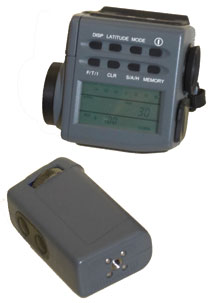Shutterbug’s Exclusive photokina Coverage; Accessories: Can’t Live Without ’Em
One of the great pleasures of photokina is finding really brilliant new accessories. Some are completely unexpected. Others, you’ve wanted for years but have never been able to find—often because until now, the technology needed to build them has not been available.
A shining example (literally) of the latter, and the accessory hit of the show as far as I am concerned, was the Korean-made Seculine Action Level, which we saw on the Kaiser stand (though it will not be imported to the US under that name—Kaiser is the German distributor). It has a five-LED “traffic light” for leveling: red for “tilted,” amber for “almost there,” green for “level.”
 |
|
|
It goes into the accessory shoe; and at the highest sensitivity setting it enables you to level the camera left/right to an accuracy of better than 10 seconds of arc (under 0.2?), whether the camera is held “landscape” (horizontal) or “portrait” (vertical). As 0.2? is the minimum adjustment I ever make in Adobe’s Photoshop, and as I am very bad at holding my cameras level, this new electronic level is a dream come true. I use it mostly handheld; my wife Frances Schultz uses it mostly on the tripod; and we both like it so much that there’s already a “mini review” on www.rogerandfrances.com, under “reviews.”
Of course it’s not perfect. I’d like a Leica version where the level is closer to the eyepiece of my M8; I’d prefer red-red-green-red-red to the current red-amber-green-amber-red, because it would be easier to differentiate out of the corner of my eye; and the two CR1220 batteries mean yet another set of batteries in the camera bag, with a battery life of 10-15 hours (maximum brightness, on all the time) to 30 hours (Power Save mode, minimum brightness).
 |
|
|
Still in the realms of leveling—look, I said I was bad at it—Seagull showed a three-way bubble level which again allows leveling on all axes without having to remove and refit it as you normally have to with a two-way level. Being Seagull, they had no retail price and no US importer and I had to borrow it from the man they’d sold it to in order to photograph it—the day before the show ended! On the last day, many people sell samples off the stand, in order not to have to ship big, heavy stuff home, but selling your only sample of a tiny product, 30 hours before the show closes, is not a good idea.
Seagull also had a clever-looking clamp to be used for supporting cameras, lighting, or anything else on location, locking around a railing, tree branch, (slim) lamppost, bicycle tube, or whatever else you have handy. Two rubber-lined V-shaped cast-alloy jaws are held together by a clip on one side and by a twin cable on the other. The clip can open completely in order to fit it around almost anything. Again, no importer, no price.
 |
|
|
Another semi-prototype that I can’t wait to get my hands on in finished form was a new spot meter from Kenko. Kenko’s meters started out as derivations of the old Minolta line-up but this is a completely new design with a detachable handle. The upper part looks like a mini camcorder, and has selectable metering down to 1?, while the handle is merely a bigger battery container allowing longer battery life. As sheer bulk is one of the strongest arguments against most spot meters, Kenko’s new spot meter looks like an absolute winner—especially if it is as ergonomic as the old Minolta meter, which looks as if it is the case. Kenko is brought into the US by THK Photo Products.
 |
|
|
Among meters I also quite fancy Gossen’s revised Starlite 2 “do-it-all” meter (spot, reflected, incident): functionally similar to the old Starlite, but more ergonomic. (Distributed in the US by Bogen Imaging, Inc.) And if you’re in the market for a color temperature meter, there’s a very good new one from Sekonic, the less than happily named PRODIGI COLOR.
 |
|
|
A much simpler accessory is the baLens White Balance Lens Cap from BRNO—though confusingly, BRNO is the name of the California-based company that sells it, not the city in the Czech Republic after which the company is named. This is basically a very well-made clip-in lens cap with an interchangeable white dome in the middle, looking a bit like the incident light dome on a light meter. It’s for setting manual white balance on digital cameras: instead of pointing the camera at a white board, you just leave the lens cap on. Although it’s surprisingly expensive (in the $50 range, though this had not been finalized at the time of this writing), it is also extremely convenient and, as I say, very well-made. Why interchangeable domes? One for neutral balance, one for warm. Current cap sizes are 52, 55, 58, 62, 67, 72, 77mm; others may be added if there is enough demand. BRNO LLC does not have a website but are at 1521 Greenfield Ave., Ste. 102, Los Angeles, CA 90025 and are distributed by HP Marketing Corp.
 |
|
|
An even simpler accessory, from Explorer Cases, was a little metal box with perforations to hold silica gel packs. Silica gel arrives with most of the new equipment you buy nowadays, in a little fabric bag labeled “SILICA GEL—Do not eat.” This is good advice, though the other injunction that often appears on the bag, “THROW AWAY” is rendered nugatory by this box. Silica gel bags can be regenerated indefinitely via an hour or so in a cool oven (100?C/200?F) and can then sop up more moisture in your camera bag or camera cupboard; stick the camera in a Zip Loc or similar with a silica gel bag when you aren’t using it for a long period.
 |
|
|
































